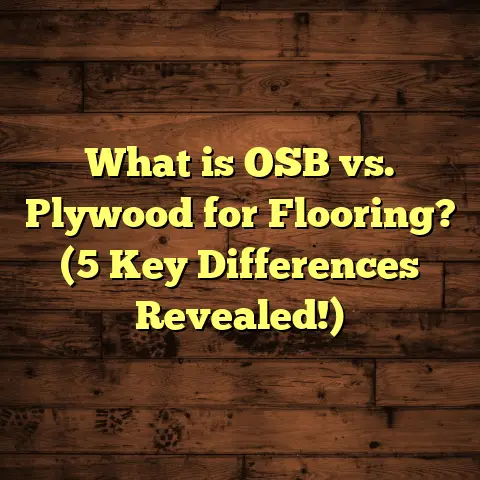What is Flooring Made Of? (5 Materials You Didn’t Expect)
Sustainability has become a big part of how I approach home projects, especially flooring. Every time I think about what floors I want to install or recommend, I ask myself: How will this material affect the environment? How long will it last? Can it be reused or recycled? Flooring isn’t just about looks or comfort anymore; it’s about making smart choices that last and don’t cost the earth.
The floor beneath our feet is more than just a surface — it’s the foundation of our daily lives, influencing comfort, style, and even health. Over the years, I’ve installed floors in countless homes and businesses, and I’ve come to appreciate the variety of materials available beyond the usual wood, tile, or carpet. Some surprising options offer incredible benefits, especially if you’re thinking about sustainability and longevity.
So, when people ask me, “What is flooring made of?” my answer goes beyond just wood or tile. There are plenty of materials out there that might surprise you — materials that bring durability, style, and sustainability all in one package. Today, I want to share five such materials with you. These aren’t just trendy picks; they’re options I’ve worked with personally and seen stand the test of time.
What is Flooring Made Of?
At its core, flooring is the material laid down to cover the floor surface of a building. But what makes up those materials? And why do some last longer or look better than others? Flooring materials can be natural, synthetic, or a mix of both. They can come from wood, stone, plastic, or even recycled elements.
To get real about it — flooring is what you walk on every day. It needs to be durable enough to handle foot traffic but also fit the vibe of your space. The choice of material affects everything from how easy it is to clean, how it feels underfoot, to how eco-friendly it is.
I’ve learned over time that the best flooring option is one that balances these factors based on your unique needs. That’s why I’m excited to share five materials that might not be top of mind but deserve a serious look.
1. Cork Flooring: Nature’s Soft Touch
The Story Behind Cork
My first encounter with cork flooring was in an eco-conscious yoga studio project. The client wanted something natural, comfortable for barefoot standing, and environmentally responsible. I didn’t know much about cork then except that it came from trees. After installing it and living with it for a few months, I realized how much cork had to offer beyond being “just another floor.”
Cork comes from the bark of cork oak trees primarily found in Mediterranean countries like Portugal and Spain. What makes cork special is how it’s harvested — the trees aren’t cut down. Instead, the bark is stripped carefully every 9 years or so, allowing the tree to regenerate its bark naturally. This makes cork a renewable resource.
Why Cork Works So Well
- Softness and Comfort: Cork has a natural springiness due to its cellular structure filled with air pockets. Walking on cork feels cushioned — a great benefit for kitchens or standing desks.
- Thermal Insulation: Cork’s air pockets also trap heat, making floors feel warmer in winter and cooler in summer. This can reduce energy bills slightly by improving insulation.
- Sound Dampening: Because cork absorbs sound vibrations, it reduces noise significantly indoors. In multi-level homes or apartments, this makes a big difference.
- Resistant to Mold and Pests: Cork contains suberin, a waxy substance making it naturally resistant to mold and insect damage.
The Durability Question
When I first recommended cork flooring for a busy household with kids and pets, I wondered if it would hold up over time. Cork is softer than hardwoods, so it can dent or scratch with sharp objects or heavy furniture if unprotected.
However, after sealing the surface properly and using furniture pads, the cork held up impressively well for over 5 years without major issues. It’s not indestructible but can last 20+ years in residential settings with care.
Sustainability Data
Cork forests actually help reduce carbon dioxide in the atmosphere — studies show cork oak ecosystems absorb roughly 5 million tons of CO2 annually worldwide. Additionally, harvesting cork supports biodiversity by maintaining habitats for endangered species like the Iberian lynx.
Practical Tips for Using Cork Floors
- Always seal cork floors with a water-based polyurethane finish for protection.
- Use area rugs or mats in high-traffic zones.
- Clean with a damp mop; avoid soaking water.
- Avoid dragging heavy furniture directly on cork.
- Consider cork for bedrooms, offices, or studios where comfort matters most.
2. Bamboo: More Than Just a Trend
Why Bamboo Stands Out
I remember visiting a client in California who insisted on bamboo flooring despite some skepticism from neighbors. After living with it for 3 years myself in another home, I got why bamboo has earned its place among popular sustainable flooring options.
Bamboo is technically a grass but grows fast — much faster than hardwood trees. It takes about 3-5 years to mature versus decades for oak or maple. This rapid renewability makes bamboo attractive if you want a floor that’s both stylish and eco-friendly.
Strength and Appearance
What surprised me was bamboo’s durability. Strand-woven bamboo, which involves compressing bamboo fibers under heat and pressure with adhesives, can be twice as hard as oak hardwood. This makes it suitable for high-traffic areas.
Aesthetically, bamboo floors have a clean, modern look with natural grain patterns ranging from light blonde to deep caramel tones. They bring warmth without looking overly rustic.
Real-Life Durability Test
In one commercial project—a busy café—strand-woven bamboo resisted scratches from chairs and dropped utensils better than expected. Maintenance was simple: routine sweeping and occasional mopping kept it looking great.
Environmental Impact
Bamboo absorbs carbon dioxide while growing — estimates suggest one hectare of bamboo plantation can absorb up to 62 tons of CO2 per year compared to 10-15 tons absorbed by hardwood forests of similar size.
Moreover, responsibly harvested bamboo reduces pressure on hardwood forests globally.
What to Watch Out For
- Avoid cheap bamboo flooring made with formaldehyde-based adhesives.
- Look for products certified by Greenguard or FSC.
- Keep bamboo floors dry; moisture can cause warping.
- Use felt pads under furniture legs.
3. Recycled Glass Tiles: Art Meets Eco-Friendly Flooring
A Unique Option That Caught My Eye
I first encountered recycled glass tiles working on a boutique hotel renovation where the designer wanted something artistic yet sustainable for the lobby floor. The glass tiles created an eye-catching mosaic effect while staying eco-conscious.
Unlike traditional ceramic tiles made from mined clay and minerals, recycled glass tiles reuse glass waste like bottles and jars that would otherwise end up in landfills.
Benefits Beyond Looks
- Environmental Impact: Recycling one ton of glass saves over 1,300 pounds of raw materials like sand and soda ash.
- Durability: When installed properly with strong adhesives and grout, glass tiles last decades.
- Light Reflection: Glass tiles bounce light around rooms beautifully, enhancing brightness without extra lighting costs.
- Non-Toxic: No VOCs or harmful chemicals off-gassed after installation.
Practical Insights from Installation
Glass tiles are harder to cut and install compared to ceramic tiles but worth the extra effort for their unique look and feel.
In residential kitchens or bathrooms where moisture is common, glass tiles resist staining and don’t harbor bacteria.
Statistics That Impress
- Glass recycling rates have improved globally but still lag behind metals and paper—using recycled glass in flooring helps close this gap.
- Approximately 27 million tons of glass waste are generated annually in the US alone; reusing even a fraction reduces landfill strain.
Tips for Glass Tile Floors
- Use non-abrasive cleaners to avoid scratching.
- Choose slip-resistant textures if installing on wet-prone floors.
- Combine glass tiles with underfloor heating for added comfort.
- Expect professional installation costs higher than ceramic tile due to labor intensity.
4. Linoleum: The Old-School Comeback
Why Linoleum Deserves Another Look
For years linoleum got overshadowed by vinyl flooring due to their similar names but very different compositions. Linoleum is made from natural ingredients like linseed oil (flaxseed oil), cork dust, wood flour, and jute backing — all renewable resources.
I installed linoleum floors in a small bakery where hygiene was critical; its antibacterial properties impressed the owner and staff alike.
Performance Over Time
Linoleum can last longer than vinyl—up to 40 years when maintained properly versus vinyl’s typical 10–20 year lifespan.
It’s naturally resistant to bacteria and mold because linseed oil oxidizes to form a tough protective layer on the surface.
Sustainability Credentials
Using linoleum means choosing biodegradable materials rather than petroleum-based plastics common in vinyl flooring.
Linseed oil harvesting supports farmers growing flax sustainably across Europe and North America.
My Experience With Linoleum Care
Linoleum needs a little more love than vinyl:
- Annual application of protective finish is necessary.
- Avoid harsh chemicals during cleaning; mild soap works best.
- Standing water should be wiped away quickly to prevent damage.
- Patterns hide dirt well; plain colors show wear faster.
Despite these quirks, linoleum offers a warm feel underfoot compared to cold vinyl or tile options.
5. Terrazzo: Beyond Marble Chips
Ancient Technique Meets Modern Sustainability
Terrazzo floors have been used since Roman times but have seen renewed interest because they combine beauty with durability and ecological benefits.
Terrazzo consists of chips of marble, quartz, granite, glass mixed into cement or resin base. More recently, crushed recycled glass is often incorporated into terrazzo mixes.
I remember working on a university library project where terrazzo floors replaced old carpet — the result was stunningly durable floors that brightened up large spaces with colorful chips reflecting natural light.
Why Terrazzo Stands Out
- Longevity: Terrazzo floors can last 75+ years with minimal maintenance.
- Recycled Content: Incorporating recycled aggregates reduces landfill waste.
- Low Maintenance: Sealed terrazzo resists stains easily.
- Thermal Mass: Terrazzo helps stabilize indoor temperatures by absorbing heat during the day and releasing it at night.
Environmental Impact Data
Using recycled glass or marble chips means less mining for virgin stone materials—a big win for ecosystems around quarries.
Also, terrazzo’s durability means fewer replacements over time—saving energy and raw materials on manufacturing new floors repeatedly.
Installation Insights
Terrazzo installation requires skilled labor because mixing ratios and placement techniques affect final durability and appearance.
Sealing terrazzo every couple of years keeps floors looking new by preventing moisture infiltration and staining.
Putting It All Together: Choosing the Right Flooring Material for You
After working with these materials in various projects — from cozy homes to commercial spaces — I’ve seen how each brings something different to the table:
| Material | Sustainability | Durability | Comfort | Maintenance | Ideal Use Cases |
|---|---|---|---|---|---|
| Cork | Renewable bark harvesting | Medium (20+ years) | Soft & warm | Seal & mop regularly | Bedrooms, offices, low traffic |
| Bamboo | Fast-growing grass | High (strand-woven) | Firm & smooth | Avoid moisture | Homes with pets/kids, commercial |
| Recycled Glass | Diverts landfill waste | High (decades) | Cool & reflective | Gentle cleaners | Bathrooms, kitchens, decorative |
| Linoleum | Natural biodegradable ingredients | Very high (40+ years) | Warm & resilient | Protective finish annual | Kitchens, healthcare, cafes |
| Terrazzo | Uses recycled aggregates | Very high (75+ years) | Hard & cool | Seal every couple years | High traffic public/commercial |
Final Thoughts on Flooring Materials You Didn’t Expect
Choosing flooring isn’t just about picking something pretty or cheap. It’s about finding the right balance between style, function, and sustainability. I’ve seen firsthand how these five materials—cork, bamboo, recycled glass tiles, linoleum, and terrazzo—can transform spaces while respecting our planet.
If you’re thinking about your next flooring project, ask yourself:
- How long do I want this floor to last?
- What kind of foot traffic will it handle?
- How important is eco-friendliness in my choice?
- Will this material fit my lifestyle (kids, pets, moisture)?
Each option has its strengths and quirks. Don’t hesitate to reach out if you want advice tailored for your space or need help weighing these materials against more traditional ones like hardwood or tile.
I’ve learned that sometimes the unexpected choices are the best ones—both for your home and the environment.
Additional Resources You May Find Helpful
If you want more detailed cost comparisons or local labor rates for these materials, tools like FloorTally offer great support by providing real-time estimates based on your area’s market conditions. Using such tools can save time budgeting your project realistically without chasing multiple quotes.





